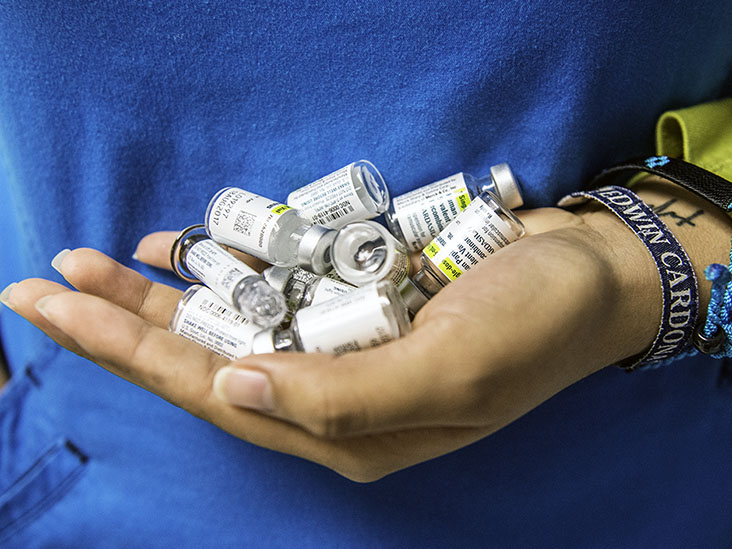
- Human papillomavirus (HPV) causes cervical cancer and primarily affects people in low- and middle-income countries.
- Recommendations currently suggest women and girls need multiple doses of an HPV vaccine for it to be effective.
- In the present study, the researchers found that a single dose of an HPV vaccine was as effective as a multi-dose vaccine.
A single-dose human papillomavirus (HPV) vaccine can be as effective as the three-dose regimen which is the current standard, a new study in Africa found.
The research, published in NEJM Evidence, could help speed up the rate at that women are vaccinated against the virus, reducing its effectiveness at the level of the population.
Cervical Cancer and HPV
According to the World Health Organization (WHO), in 2020 342,000 women died due to cervical cancer. 90% of these deaths occurred in low- or middle-income countries.
HPV — and in particular its serotypes 16 and 18 — account for 50% of high-grade cervical pre-cancers.
Currently, women and girls can be vaccinated against HPV, but according to the U.S. Centers for Disease Control and Prevention (CDC), this requires a two- or three-dose regimen.
The need for multiple doses slows down the rate at which women and girls can be vaccinated. This is particularly the case in low- or middle-income countries, where there is less infrastructure and less money to enable rapid, widespread vaccination.
Researchers have found that having more people vaccinated reduces the spread of HPV at a population level.
According to WHO Assistant Director-General Dr. Princess Nothemba (Nono) Simelela, the new study’s findings may help with the goal of eliminating cervical cancer.
“I firmly believe the elimination of cervical cancer is possible,” says Dr. Simelela.
“In 2020 the Cervical Cancer Elimination Initiative was launched to address several challenges including the inequity in vaccine access. This single-dose recommendation has the potential to take us faster to our goal of having 90% of girls vaccinated by the age of 15 by 2030.”
A randomized, controlled trial
The randomized, controlled trial involved 2,275 women and girls aged between 15 and 20.
Eligibility included being negative for human immunodeficiency virus, being sexually active, having no more than five sexual partners during their lives, and not having previously been vaccinated against HPV.
The participants were randomly assigned to one of three groups.
A bivalent HPV vaccine — that creates an immune response to two different antigens — was given to 760 of the participants. A nonavalent HPV vaccine — that creates an immune response to nine different antigens — was given to 758 of the participants. Finally, a meningococcal meningitis vaccine was given to 757 participants.
Single-dose highly effective
The researchers found that after 18 months, the single doses of both the bivalent and nonavalent vaccines were 97.5% effective against HPV 16 and 18.
Dr. Ruanne Barnabas — Chief of the Division of Infectious Diseases at Massachusetts General Hospital and the Principal Investigator of the study — says that “the single-dose efficacy was the same as multiple doses.”
According to Dr. Alejandro Cravioto — the Chair of the WHO Strategic Advisory Group of Experts on Immunization (SAGE) — the study’s findings mean that a single dose of an HPV vaccine can be recommended for many girls and women.
Dr. Cravioto says that “SAGE urges all countries to introduce HPV vaccines and prioritize multi-age cohort catch up of missed and older cohorts of girls.”
“These recommendations will enable more girls and women to be vaccinated and thus prevent them from having cervical cancer and all its consequences over the course of their lifetimes.”
While the evidence for a new single-dose regimen is exciting, it will also require political and economic support for lower- and middle-income countries to realize its potential.
Dr. Simelela says that “we need political commitment complemented with equitable pathways for the accessibility of the HPV vaccine. Failure to do so is an injustice to the generation of girls and young women who may be at risk of cervical cancer.”
“The option for a single dose of the vaccine is less costly, less resource-intensive, and easier to administer. It facilitates implementing catch-up campaigns for multiple age groups, reduces the challenges linked to tracing girls for their second dose, and allows for financial and human resources to be redirected to other health priorities.”
Source: Read Full Article
